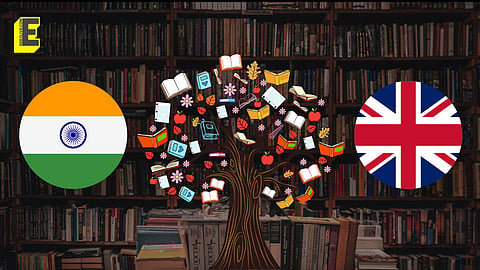

Pierpaolo Rovero’s impressively detailed artwork titled Present Past Future is about books, about the space they inhabit, and about the unknown realm they lead us to. The masterpiece draws you in organically and invokes a certain sense of wistful yearning.
The accompanying nostalgia is replete with endless alleys of books arranged by their spines, enveloped by an earthy waft, and a blanket of silence so deafening one could hear a pin drop.
The instant connect with Rovero’s artwork perhaps traces its roots to an era when visiting a library was not just an intellectual pursuit but an unmatched sensory experience. Like everything else, the world of libraries too has spatially evolved, architecturally bolstered by cloud computing, Internet of Things (IoT), Artificial Intelligence (AI), Machine Learning (ML), Radio Frequency Identification (RFID) technology, etal.
Post the COVID pandemic most libraries began to increase their digital holdings, and some began to completely reinvent themselves to stay apace. They are deploying technology — from intelligent operating system for book acquisition, classification, and cataloguing to interactive customised digital library services such as self-checkout — to enhance user experiences, streamline operations, and improve efficiencies.
For example, at Singapore’s Nanyang Technological University (NTU) Library, Temi, the Smart Library Bot will help you navigate through the sea of books and lead you right to the shelf where the book you want is kept.
The anatomy of a library is changing in small ways and big as it transcends the physical space and transforms into a dynamic, digital learning hub. If estimates hold true, Smart Library market will grow at a Compound Annual Growth Rate (CAGR) of 11.22% and touch $44.21 billion by 2031.
Smart or digital libraries are much more than simple repositories of knowledge and information. They champion the cause of digital equity by making information accessible and affordable. There was a time when students, writers, and researchers struggled to access scholarly resources available in libraries in other cities or countries.
Today, a scholar residing in London can remotely access WW Hunter’s Annals of Rural Bengal, published in 1871, effortlessly through the digital archives of the Delhi-based Prime Ministers Museum and Library.
Or for that matter, Sir William Stevenson Meyer’s 1909 edition of Imperial Gazetteer of India at the Digital South Asia Library. This accessibility is equally valuable for the elderly and those with physical challenges.
Digital libraries are not only completely redefining how patrons are accessing content but also addressing the pervasive challenge posed by the exponential growth of scholarly publications in the face of limited shelf space. Consider JSTOR, a virtual platform which has forged partnerships with libraries, publishers, and museums to provide access to more than 12 million journal articles, 1,00,000 books, and 2 million images and primary sources in 75 disciplines globally. Everything in just a few clicks.
History stands witness to the monumental, multifaceted roles libraries have played in societies world over.
United Nations Educational, Scientific and Cultural Organization's (UNESCO) Public Library Manifesto, first published in 1949, captures the essence succinctly affirming them to be a living force for education, culture and information, and also an essential agent for the fostering of peace and spiritual welfare.
Precisely why one of the objectives of its Information for All Programme is to support the safeguarding of documents held by museums, libraries and archives through their organisation, digitisation, preservation, and dissemination.
Even in their digital avatars, some libraries do serve as vibrant social spaces. They are using virtual tools to create connections with and among community members.
The British Council Smart Library, for instance, has made it plausible through online community engagements such as ‘Art of Storytelling’ sessions, ‘Book clubs,’ ‘Writers’ Circle,’ ‘Poetry Circle,’ cultural events, and ‘Online Reading Marathons’ for young adults and children. It also helps its members forge global connections through its international programmes while bridging the linguistic and language gaps by offering the facility of reading and listening with translation in 23 languages.
More importantly, technology helps in upgrading legacy formats such as paper and CD ROMs that are otherwise extremely vulnerable to obliteration. It makes one wonder what would have happened if technology existed 2000 years ago. Could it have averted the tragic loss of the Great Library at Alexandria, believed to have been visited by great minds like Eratosthenes and Hipparchus?
JSTOR, having technologically fortified itself against such contingencies, may have a cue to offer: The digital content it has created can be converted into newer formats and it utilises data centre redundancy to insure against any losses.
Indeed, the power of technology is remarkable in more ways than one can imagine. The transformation of libraries, thus, is a move in the right direction to preserve the legacy of learning.
(Viji Thiyagarajan is Director of Libraries South Asia, British Council. Views expressed are her own.)
